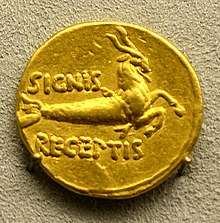Sea goat
A sea goat is a legendary aquatic animal described as a creature that is half goat and half fish.[2]
 | |
| Grouping | Legendary creature |
|---|---|
| Sub grouping | Hybrid |
| Region | Greece, Israel, Mesopotamia |
The constellation Capricornus was commonly imagined as a type of sea goat. This has been done since the Bronze Age within Mesopotamia. Then the Babylonians used MUL SUḪUR.MAŠ, 'the goat fish', to symbolize the god Enki.[3][4]
Greek tradition
Concepts regarding sea goats existed in ancient Greek mythology. Many studies based upon the subject have connected the allegory of the sea goat to the zodiac Capricorn as well, although its origin is not entirely known. As per the legend, the very first sea goat named Pricus, was created by the deity Chronos. Later on, Pricus started the race of all other sea goats, who were very clever and able to speak and dearly loved by the gods.[5] They enjoyed to dwell on the seashore, but once they made it onto land, the sea goats automatically transformed into normal goats. Pricus, who had the faculty of his father Chronos, could control time. Not wanting his children to leave his side, he reversed time over and over so they would return. But in the end Pricus decided to let them go, leaving himself as the final sea goat.[6]
Jewish tradition
In Jewish oral history, mentions of sea goats also crop up. Stated in the stories, once the time comes all the creatures of the sea must offer themselves to the monster leviathan. It is purported that a sailor once encountered a sea goat while far out on the ocean. On its horns the words "I am a little sea-animal, yet I traversed three hundred parasangs to offer myself as food to the leviathan" were found carved.[7]
See also
References
- Tamsyn Barton (1995). "Augustus and Capricorn: Astrological Polyvalency and Imperial Rhetoric". The Journal of Roman Studies. Society for the Promotion of Roman Studies. 85: 47.
- "The Capricorn goat/sea goat". Mythology. Gods and Monsters.
- Rogers, John H. (1998). "Origins of the ancient constellations: I. The Mesopotamian traditions". Journal of the British Astronomical Association. 108: 9–28. Bibcode:1998JBAA..108....9R.
- Espak, Peeter (2006). Master's Thesis (PDF) (Masters). p. 104.
- "Capricorn mythology". Mythology. Gods and Monsters.
- "Capricorn the goat". starsignstyle.com.
- Louis Ginzberg. (1909) Legends of the Jews. Entries: Vol I, "The Creation of the World: The Sixth Day" and Vol IV, "Elisha and Jonah: Jonah in the Whale".